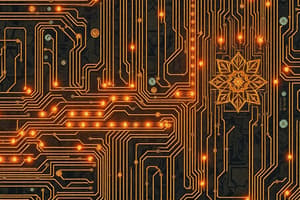Podcast
Questions and Answers
Explain the concept of triggerings in flip flops and its significance in sequential logic?
Explain the concept of triggerings in flip flops and its significance in sequential logic?
Triggering in flip flops refers to the specific conditions required for the input signals to cause a change in the output. It is significant in sequential logic as it determines when the input signals are sampled and when the output changes, ensuring the proper functioning of the flip-flop and the sequential circuit it is a part of.
Describe the design procedure and steps involved in designing a counter using flip flops and equations.
Describe the design procedure and steps involved in designing a counter using flip flops and equations.
The design procedure for a counter involves determining the number of flip flops required, selecting the type of counter (e.g., ripple or synchronous), deriving the state transition table, creating the excitation table, and then designing the flip-flop circuit based on the equations derived from the tables.
Explain the concept of processor organization and its role in digital logic systems.
Explain the concept of processor organization and its role in digital logic systems.
Processor organization refers to the arrangement and interconnection of various functional units within a processor, including the control unit, arithmetic logic unit, and registers. It plays a crucial role in digital logic systems by coordinating the execution of instructions, managing data flow, and controlling the overall operation of the processor.
Flashcards are hidden until you start studying
Study Notes
Triggerings in Flip Flops
- Triggerings in flip flops refer to the clock signal that triggers the flip flop to change its state, either from 0 to 1 or from 1 to 0.
- There are two types of triggerings: positive edge triggering and negative edge triggering.
- Positive edge triggering occurs when the clock signal transitions from 0 to 1, causing the flip flop to change its state.
- Negative edge triggering occurs when the clock signal transitions from 1 to 0, causing the flip flop to change its state.
Design Procedure for Counters using Flip Flops
- The design procedure involves the following steps:
- Define the counter's specifications, including the number of bits and the counting sequence.
- Choose the type of flip flop to use, such as SR, D, or JK flip flops.
- Derive the equations for the flip flops based on the counting sequence.
- Draw the circuit diagram, including the flip flops, logic gates, and clock signal.
- Verify the counter's operation using truth tables or simulation.
Processor Organization
- Processor organization refers to the design of the digital system that executes software instructions.
- The key components of processor organization include:
- Instruction Fetch Unit (IFU): retrieves instructions from memory.
- Instruction Decoder: decodes instructions into machine-readable format.
- Execution Unit: executes instructions.
- Registers: store data temporarily.
- Memory Management Unit (MMU): manages memory access.
- The role of processor organization in digital logic systems is to execute instructions efficiently and effectively, enabling the system to perform tasks and operations.
Sequential Logic Systems
- Sequential logic systems use flip flops to store and manipulate data.
- The key characteristics of sequential logic systems include:
- Feedback paths: allow the output of the system to affect its input.
- Latches: store data temporarily.
- Flip flops: store data and change state based on clock signals.
- Sequential logic systems are used in digital systems, such as computers, smartphones, and embedded systems, to perform complex tasks and operations.
Studying That Suits You
Use AI to generate personalized quizzes and flashcards to suit your learning preferences.




